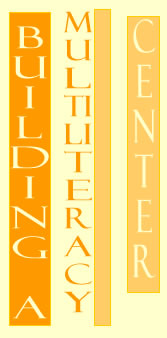

Reclaiming Meaningful and Valued Representations
KHM:
How do you answer your department or institution when asked, "Why
should the academy care about fostering multiliteracies? Why should we
incorporate Multiliteracy Centers into our university writing centers
and settings?"
DS: I think that's the key question that educators at all levels need to really think about. The article I mentioned earlier by the New London Group is, as far as I know, to date the most comprehensive outline of why we should be concerned with multiple literacies as educators. And, in particular, Gunther Kress, who is part of the New London Group, has written his own articles explaining how we should reinvent specifically the English studies curriculum. In these models, the theorists tend to begin with the assumption that one thing that education does is it prepares students to participate as fully as possible in the professional and in the social lives of the culture that they are a part of. So, look around, look at our culture. We are an intensely multimodal culture. TV, films, print media -- our culture is very multimodal; it employs words, photographs, design components, media elements, sounds. Face to face interaction is multimodal: it involves the spoken word but it also involves all kinds of nonverbal communication.
So, humans are intensely multimodal. Our culture in an electronic age is intensely multimodal. And if students are going to fully participate in this culture, then they need to have sophisticated understanding of multimodal communication. They need multiple literacies. And, once you start to think about that, you also see that it opens up all kinds of really exciting possibilities.
My particular research interest is the city of Detroit. And, in my dissertation, I look at signifying practices associated with the city of Detroit. What you find is that a lot of corporate media depictions of the city focus on what Detroit lacks -- that Detroit lacks people, it lacks meaning, it lacks a culture, it lacks order. It lacks all the things that humans want to make a meaningful life. What those depictions focus on are drugs, poverty, crime, and violence. And, if you're not careful, that's all you're going to see about Detroit. Even if you live in the suburbs -- maybe especially if you live in the suburbs -- that's pretty much all you're going to see of Detroit. Because on the nightly news, you tend to get coverage of whatever crime was committed that night, whatever drug bust was made, whatever dead body was discovered. And that's going to be your picture of Detroit, because that's what sells and that's what corporate media values. But it should go without saying that there's lots more to Detroit than what's covered on the nightly news and what's covered in any form by corporate media. There's a lot more to the city that's not being depicted and that's not being told as visibly as it should be.
This
relates to multiple literacies because if you have a citizenry that is
trained to take advantage of the multimodal communication that's enabled
by digital technologies, then what you have are people who can, for instance,
create rhetorically effective websites that integrate words, sounds, images,
and all kinds of media components in ways that they find meaningful, in
ways that effectively represent their realities and tell their stories.
And, in a way, you already see this happening. You see neighborhood groups
creating websites that present a much richer depiction of Detroit, that
present things that are valuable to those groups.
Top | Next